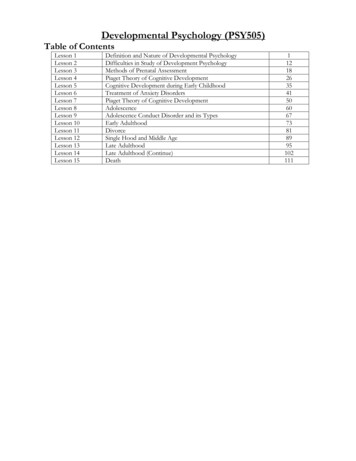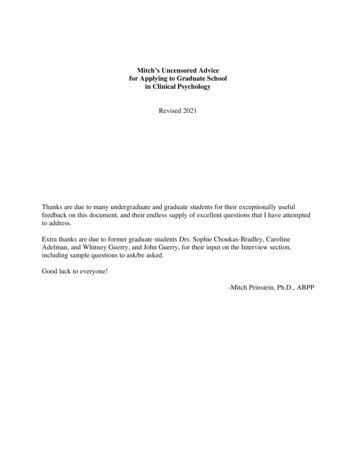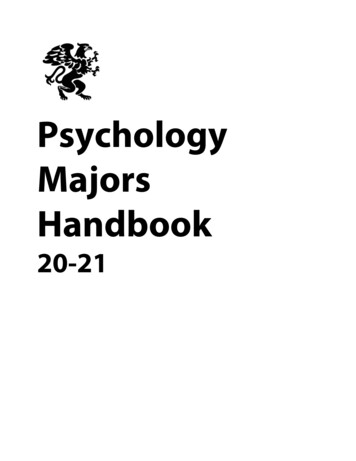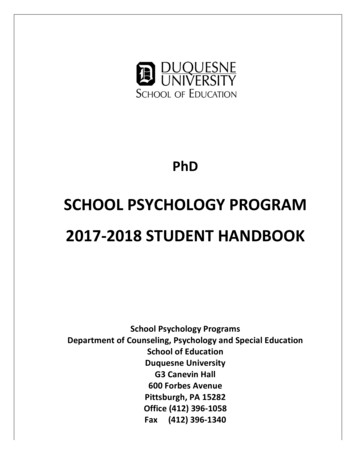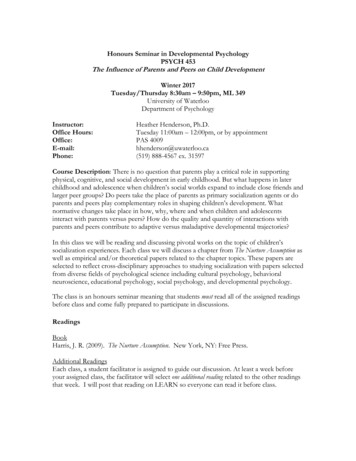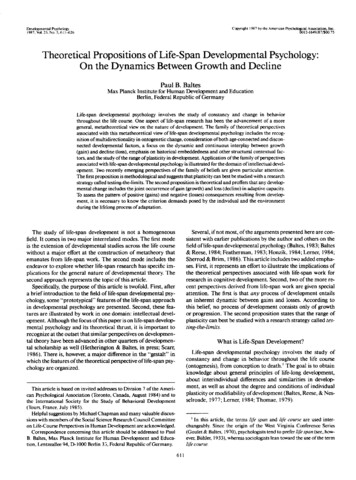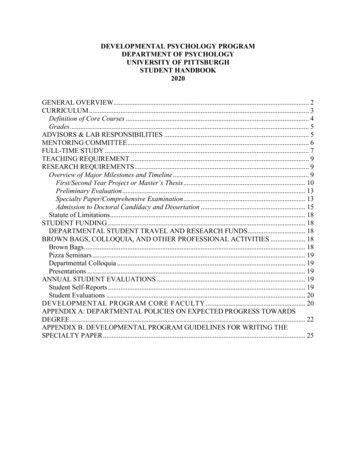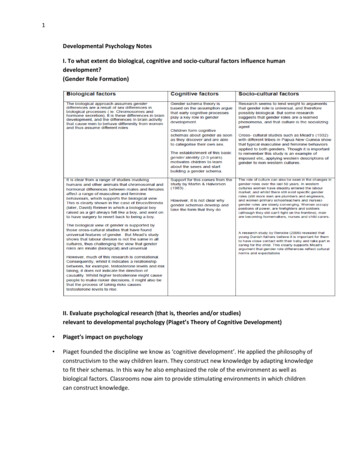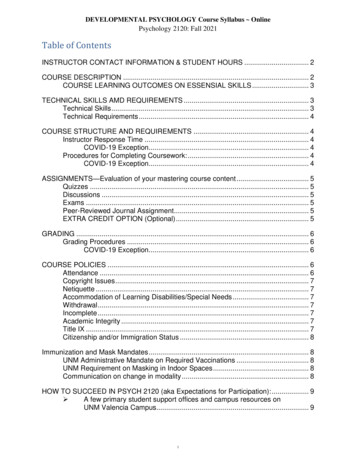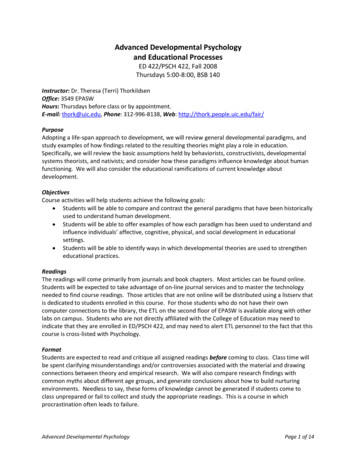
Transcription
Advanced Developmental Psychologyand Educational ProcessesED 422/PSCH 422, Fall 2008Thursdays 5:00-8:00, BSB 140Instructor: Dr. Theresa (Terri) ThorkildsenOffice: 3549 EPASWHours: Thursdays before class or by appointment.E-mail: thork@uic.edu, Phone: 312-996-8138, Web: http://thork.people.uic.edu/fair/PurposeAdopting a life-span approach to development, we will review general developmental paradigms, andstudy examples of how findings related to the resulting theories might play a role in education.Specifically, we will review the basic assumptions held by behaviorists, constructivists, developmentalsystems theorists, and nativists; and consider how these paradigms influence knowledge about humanfunctioning. We will also consider the educational ramifications of current knowledge aboutdevelopment.ObjectivesCourse activities will help students achieve the following goals: Students will be able to compare and contrast the general paradigms that have been historicallyused to understand human development. Students will be able to offer examples of how each paradigm has been used to understand andinfluence individuals’ affective, cognitive, physical, and social development in educationalsettings. Students will be able to identify ways in which developmental theories are used to strengtheneducational practices.ReadingsThe readings will come primarily from journals and book chapters. Most articles can be found online.Students will be expected to take advantage of on-line journal services and to master the technologyneeded to find course readings. Those articles that are not online will be distributed using a listserv thatis dedicated to students enrolled in this course. For those students who do not have their owncomputer connections to the library, the ETL on the second floor of EPASW is available along with otherlabs on campus. Students who are not directly affiliated with the College of Education may need toindicate that they are enrolled in ED/PSCH 422, and may need to alert ETL personnel to the fact that thiscourse is cross-listed with Psychology.FormatStudents are expected to read and critique all assigned readings before coming to class. Class time willbe spent clarifying misunderstandings and/or controversies associated with the material and drawingconnections between theory and empirical research. We will also compare research findings withcommon myths about different age groups, and generate conclusions about how to build nurturingenvironments. Needless to say, these forms of knowledge cannot be generated if students come toclass unprepared or fail to collect and study the appropriate readings. This is a course in whichprocrastination often leads to failure.Advanced Developmental PsychologyPage 1 of 14
AssignmentsTo remain responsive to the ebb and flow of the discussion, assignments will not require a fixed set ofreadings and students are encouraged to share suitable materials that they read for this and othercourses in their conversations. The syllabus is posted online and changes may occur across thesemester. To comply with programmatic needs, a predetermined set of topics has been established andare listed in the tentative schedule. Those topics are sufficiently broad to cover the requirementsestablished for this course, but students will be encouraged to tailor their thinking to consider the agegroup they are most likely to work with in the future.Assignments measure the degree to which students are able to construct general relationshipsbetween topics and back up their conclusions with research and practical evidence. Tasks fall into threecategories: assessment of group discussions, a conceptual mid-term, and a final application-focusedproject. The assignments will focus on three sources of evidence (research findings, mediarepresentations, and details of lives in progress) although these will be weighted differently in varioussegments of the course.Group discussions. Students will be assigned to small groups based on their interests andreasons for exploring human development. Each week, groups will meet during class time to discuss thereadings and imagine ways to use the information in practice. Group members will take turnsdocumenting the details of each discussion. The note-takers of the week will be responsible forrecording the content of the discussion as well as who offered each contribution. (Some groups mayprefer to record the discussion and transcribe their conversation, but an accurate gist is alsoacceptable.) The notes should be typed up for critique by group members in the following class.Members may edit these notes, add amendments, or delete any material they do not feel is accurate.Group discussions, in other words, will include a critique of the accuracy of the transcript from theprevious week as well as a new conversation. Once notes are approved by the group, a set of the finalnotes should be placed in a log book that will be collected and evaluated at several points over thecourse of the semester. Because individuals will probably want to keep a personal copy to track thereadings and their progress, it is suggested that each group member generate their own copy of the logand that someone be designated the keeper of the log that will be turned in for evaluation.On the rare occasion when students find themselves unable to attend class, they will beresponsible for contributing a thought paper to the log book to represent their contribution. Individualswho miss class will also be responsible for obtaining any assigned readings and procedural informationfrom their group members. When log books are evaluated, I will look for signs of students’ intellectualgrowth over time and the degree to which individuals are coordinating information from research,media sources, and lives in progress. Labeling the contributions of each group member to eachconversation ensures that students’ grades are not caused by variation in group dynamics. Group logsalso offer each note taker practice listening to the views of others in a careful manner—and essentialskill for anyone who wants to understand human development.Mid-term exam. A conceptual mid-term exam will evaluate the degree to which students areable to see the forest through the trees. This take-home exam will focus primarily on relationshipsbetween particular theories of development, research findings, and age-appropriate practice. Theability to draw these connections will be essential to the successful design of a final class project.Mistakes made on the mid-term can be revised without penalty, but all revisions should be turned inbefore the final project is due.Advanced Developmental PsychologyPage 2 of 14
Final project. A final project consisting of a written paper and a group presentation will be usedto determine if students have coordinated the information necessary for understanding commonfeatures of the various developmental theories and how that information might be used to influencepractice. After the mid-term examination, the details of these projects will be negotiated with theinstructor and other group members. However, students can begin thinking about how they will find atleast one person in their target-age group who would be willing to share opinions about educationalissues.AccessibilityUIC strives to ensure the accessibility of programs, classes, and services to students with disabilities.Reasonable accommodations can be arranged for students with various types of disabilities, such asdocumented learning disabilities, vision or hearing impairments, and emotional or physical disabilities.If you need accommodations for this class, be sure to register with the Office of Disability Services, 1190SSB, 312-413-2183 (phone), and let your instructor know your needs.Advanced Developmental PsychologyPage 3 of 14
Tentative ScheduleDatesMajor TopicAge GroupsAug. 28thWhat is development?Development as a pan-contextual, life-longprocess(Guiding questions)Sept. 4thWhen does age matter?Basic paradigms(Guiding questions)Sept. 11thA dynamic systemAll ages(Guiding questions)Sept. 18thSocial changesPuberty to old age(Guiding questions)Sept. 25thSocial changesBirth to the onset of puberty(Guiding questions)Film: It’s ElementaryOct. 2ndPhysical changesBirth to the onset of puberty(Guiding questions)Group Logs DueOct. 9thPhysical changesPuberty to old ageOct. 16thCognitive changesBirth to the onset of pubertyOct. 23rdCognitive changesPuberty to old ageMidterms DueOct. 30thAffective changesBirth to the onset of pubertyNov. 6thAffective changesPuberty to old ageNov. 13thThe whole systemAll agesNov. 20thGroup presentationsFinal Logs DueNov. 27thThanksgivingsNo ClassDec. 4thGroup presentationsDec. 11thAdvanced Developmental PsychologyFinal Papers DuePage 4 of 14
Assigned ReadingsSept. 4th Basic paradigmsPick oneKohlberg, L. J., & Mayer, R. (1972). Development as the aim of education: The Dewey view. HarvardEducational Review, 42, 449-496.Wapner, S., & Craig-Bray, L. (1992). Person-in-environment transitions: Theoretical andmethodological approaches. Environment and Behavior, 24, 161-188.Optional readingsBronfenbrenner, U. (1979). The ecology of human development: Experiments by nature and design.Cambridge, MA: Harvard University Press.Smith, L. B., & Samuelson, L. K. (2003). Different is good: connectionism and dynamic systems theoryare complementary emergentist approaches to development. Developmental Science, 6, 434-439.Thelen, E. (1992). Development as a dynamic system. Current Directions in Psychological Science, 1(6),189-193.Sept. 11th A dynamic system—All agesPick oneChristopher, J. C., & Bickhard, M. H. (2007). Culture, self, and identity: Interactivist contributions to ametatheory for cultural psychology. Culture & Psychology, 13, 259-295. (Double up on readers)Geary, D. C., & Huffman, K. J. (2002). Brain and cognitive evolution: Forms of modularity and functionsof mind. Psychological Bulletin, 128, 667-698. (Double up on readers)Greenwood, C. R., Carta, J. J., Hart, B., Kamps, D., Terry, B., Arreaga-Mayer, C., Atwater, J., Walker, D.,Risley, T., & Delquadri, J. C. (1992). Out of the laboratory and into the community: 26 years ofapplied behavioral analysis at the Juniper Gardens Children’s Project. American Psychologist, 47,1464-1474.Papierno, P. B., Ceci, S. J., Makel, M. C., & Williams, W. M. (2005). The nature and nurture of talent: Abioecological perspective on the ontogeny of exceptional abilities. Journal for the Education of theGifted, 28, 312-332.Shotter, J. (2003). ‘Real presences’: Meaning as living movement in a participatory world. Theory &Psychology, 13, 435-368.Optional readingsErikson, E. H. (1993). Childhood and society. New York: Norton.Thelen, E., & Smith, L., (1994). A dynamic systems approach to the development of cognition andaction. Cambridge, MA: MIT Press.Thorkildsen, T. A., & Nicholls, J. G. (with Bates, A., Brankis, N., & DeBolt, T.). (2002). Motivation andthe struggle to learn: Responding to fractured experience. Boston, MA: Allyn & Bacon.Sept. 18th Social changes—Puberty to old ageAdolescence--Pick oneEmery, R. E., & Marholin, D. II. (1977). An applied behavior analysis of delinquency: The irrelevancy ofrelevant behavior. American Psychologist, 32 (10), 860-873. (Note: The PsychInfo database has atyping error, the word behavior is missing from the title.)Farver, J. M., Xu, Y., Bhadha, B. R., Narang, S., & Lieber, E. (2007). Ethnic identity, acculturation,parenting beliefs, and adolescent adjustment: A comparison of Asian Indian and EuropeanAmerican families. Merrill-Palmer Quarterly, 53(2), 184-215.Granic, I., & Patterson, G. R. (2006). Toward a comprehensive model of antisocial development: Adynamic systems approach. Psychological Review, 113, 101-131.Advanced Developmental PsychologyPage 5 of 14
Horn, S. (2006). Heterosexual adolescents’ and young adults’ beliefs and attitudes abouthomosexuality and gay and lesbian peers. Cognitive Development, 21, 420-440.Mattaini, M. A., & McGuire, M. S. (2006). Behavioral strategies for constructing nonviolent cultureswith youth. Behavior Modification, 30, 184-224.Raskauskas, J., & Stoltz, A. D. (2007). Involvement in traditional and electronic bullying amongadolescents. Developmental Psychology, 43, 564-575.Thorkildsen, T. A., Golant, C. J., & Cambray-Engstrom, E. (2008). Essential solidarities forunderstanding Latino adolescents’ moral and academic engagement. In C. Hudley, & A. E.Gottfried (Eds.), Academic motivation and the culture of schooling in childhood and adolescence(pp. 73-98). Oxford: Oxford University Press.Young, R. A., Marshall, S. K., Domene, J. F., Graham, M., Logan, C., Zaidman-Zait, A., Mart, A., & Lee, C.M. (2008). Transition to adulthood as a parent-youth project: Governance transfer, careerpromotions, and relational processes. Journal of Counseling Psychology, 55, 297-307.Adulthood--Pick oneDillon, J. J. (2002). The role of the child in adult development. Journal of Adult Development, 9, 267275.Kuchinke, K. P. (1999). Adult development towards what end? A philosophical analysis of the conceptas reflected in the research, theory, and practice of human resource development. AdultEducation Quarterly, 49, 148-162.Lovell, C. W., & Nunnery, J. (2004). Testing the adult development tower of Babel hypothesis:Homogenous by Perry position collaborative learning groups and graduate student satisfaction.Journal of Adult Development, 11, 139-150.Palkovitz, R. (1996). Parenting as a generator of adult development: Conceptual issues andimplications. Journal of Social and Personal Relationships, 13, 571-592.Snarey, J., & Lydens, L. (1990). Worker equality and adult development: The Kibbutz as adevelopmental model. Psychology and Aging, 5, 86-93.Optional readingsHayslip, B., Jr., Panek, P. E., & Patrick, J. H. (2007). Adult development and aging (4th ed.). Malabar, FL:Krieger Publishing.Sept. 25th Social changes—Birth to the onset of pubertyPreschool--Pick oneBigelow, A. E., MacLeaan, K., & Proctor, J. (2004). The role of joint attention in the development ofinfants’ play with objects. Developmental Science, 7, 518-526.Dunn, J., & Hughes, C. (2001). “I got some swords and you’re dead!”: Violent fantasy, antisocialbehavior, friendship, and moral sensibility in young children. Child Development, 72, 491-505.Gillespie, A. (2006). Games and the development of perspective taking. Human Development, 49, 8792.Göncü, A., Tuermer, U., Jain, J., & Johnson, D. (1999). Children’s play as cultural activity. In A. Göncü(Ed.), Children’s engagement in the world: Sociocultural perspectives (pp. 148-170). New York, NY:Cambridge University Press.Humphries, M. L. & Keenan, K. (2006). Theoretical, developmental, & cultural orientations of schoolbased prevention programs for preschoolers. Clinical Child and Family Psychology Review, 9(2),135-148.Lillard, A. (2001). Pretend play as twin earth: A social-cognitive analysis. Developmental Review, 21,495-531.Lillard, A. S., & Witherington, D. C. (2004). Mothers’ behavior modifications during pretense and theirpossible signal value for toddlers. Developmental Psychology, 40, 95-113.Advanced Developmental PsychologyPage 6 of 14
McElwain, Halberstadt, A. G., & Volling, B. L. (2007). Mother- and father-reported reactions tochildren’s negative emotions: Relations to young children’s emotional understanding andfriendship quality. Child Development, 28, 1407-1425.Moll, H., & Tomasello, M. (2007). How 14- and 18-month-olds know what’s new for others.Developmental Psychology, 43(2), 309-317.Rogoff, B. (2003). Orienting concepts and ways of understanding the cultural nature of humandevelopment. In B. Rogoff, The cultural nature of human development (pp. 3-36). New York, NY:Oxford University Press.Rutter, M. L., Kreppner, J. M., & O’Connor, T. G. (2001). Specificity and heterogeneity in children’sresponses to profound institutional privation. British Journal of Psychiatry, 179, 97-103.Middle childhood--Pick oneDunn, J., O’Connor, T. G., & Cheng, H. (2005). Children’s responses to conflict between their differentparents: Mothers, stepfathers, nonresident fathers, and nonresident stepmothers. Journal ofClinical Child and Adolescent Psychology, 34, 223-234.Dunn, J., Cutting, A. L., & Fisher, N. (2002). Old friends, new friends: Predictors of children’sperspective on their friends at school. Child Development, 73, 621-635.Gresham, F. M., Watson. T. S., & Skinner, C. H. (2001). Functional behavioral assessment: Principles,procedures, and future directions. School Psychology Review, 30, 156-172.Lease, A. M., & Blake, J. J. (2005). A comparison of majority-race children with and without a minorityrace friend. Social Development, 14, 20-41.Martin, J. (2005). Real perspectival selves. Theory & Psychology, 15, 207-224.Plomin, R., Asbury, K., & Dunn, J. (2001). Why are children in the same family so different” Nonsharedenvironment a decade later. Canadian Journal of Psychiatry, 46, 225-233.Psaltis, C., & Duveen, G. (2007). Conservation and conversation types: Forms of recognition andcognitive development. British Journal of Developmental Psychology, 25, 79-102.Rose, A. J., & Rudolph, K. D. (2006). A review of sex differences in peer relationship processes:Potential trade-offs for the emotional and behavioral development of girls and boys. PsychologicalBulletin, 132, 98-131.Thorkildsen, T. A. & Schmahl, C. (1997). Conceptions of fair learning practices among low-incomeAfrican American and Latin American Children: Acknowledging diversity. Journal of EducationalPsychology, 89, 719-727.Thorkildsen, T. A. (1991). Defining social goods and distributing them fairly: The development of conceptionsof fair testing practices. Child Development, 62, 852-862.Optional readingsDunn, J. (2004). Children’s friendships: The beginnings of intimacy. Oxford, UK: Blackwell Press.Göncü, A. (1999). Children’s engagement in the world: Sociocultural perspectives. New York, NY:Cambridge University Press.Stern, D. N. (2000). The interpersonal world of the infant: A view from psychoanalysis anddevelopmental psychology. New York: Basic Books.Oct. 2nd Physical changes—Birth to the onset of pubertyGeneral positions—may be helpfulSmith, L. B., & Thelen, E. (2003). Development as a dynamic system. Trends in Cognitive Science, 7,343-348.Preschool--Pick oneAitken, K. J., & Trevarthen, C. (1997). Self/other organization in human psychological development.Development and Psychopathology, 9, 653-677.Advanced Developmental PsychologyPage 7 of 14
Racine, T. P., & Carpendale, J. I. M. (2007). The role of shared practice in joint attention. British Journalof Developmental Psychology, 25, 3-25.Sommerville, J., & Woodward, A. (2005). Pulling out the intentional structure of action: The relationbetween action processing and action production in infancy. Cognition, 95, 1-30.Stork, S., & Sanders, S. W. (2008). Physical education in early childhood. The Elementary SchoolJournal, 108, 197-206.Thelen, E. (2005). Dynamic systems theory and the complexity of change. Psychoanalytic Dialogues,15, 255-283.Middle childhood--Pick oneMolfese, V. J., & Molfese, D. L. (2002). Environmental and social influences on reading skills as indexedby brain and behavioral responses. Annals of Dyslexia, 52, 121-137.Rhodes, R. E., Macdonald, H. M., & McKay, H. A. (2006). Predicting physical activity intention andbehavior among children in a longitudinal sample. Social Science & Medicine, 62, 3146-3156.Pellegrini, A. D., & Smith, P. K. (1998). Physical activity play: The nature and function of a neglectedaspect of play. Child Development, 69, 577-598. (Main argument)Comments and rejoinder to Pellegrini & SmithMcCune, L. (1998). Immediate and ultimate functions of physical activity play. Child Development, 69,601-603.Bjorklund, D. F., & Brown, R. D. (1998). Physical play and cognitive development: Integrating activity,cognition, and education. Child Development, 69, 604-606.Rosenbaum, P. (1998). Physical activity play in children with disabilities: A neglected opportunity forresearch? Child Development, 69, 607-608.Pellegrini, A. D., & Smith, P. K. (1998). Physical activity play: Consensus and debate. ChildDevelopment, 69, 609-610.Optional readingsKaiser, B., & Rasminsky, J. (2007). Challenging behavior in young children: Understanding, preventing, andresponding effectively. Boston, MA: Allyn & Bacon.Brown, J. W. (2002). Self-embodying mind: Process, brain dynamics and the conscious present. Barrytown, NY:Midpoint Trade Books.Oct. 9th Physical changes—Puberty to old ageAdolescence--Pick oneBiro, F. M., & Dorn, L. D. (2006). Puberty and adolescent sexuality. Psychiatric Annals, 36, 685-690.Brooks-Gunn, J., & Reiter, E. O. (1990). The role of pubertal processes. In S. S. Feldman, & G. R. Elliott(Eds.), At the threshold: The developing adolescent (pp. 16-53). Cambridge, MA: Harvard UniversityPress.Dorn, L. D., & Dahl, R. E., & Woodward, H. R., & Biro, F. (2006). Defining the boundaries of earlyadolescence: A user’s guide to assessing pubertal status and pubertal timing in research withadolescents. Applied Developmental Science, 10, 30-56.Friedlander, L. J., Connolly, J. A., Pepler, D. J., & Craig, W. M. (2007). Biological, familial, and peerinfluences on dating in early adolescence. Archives of Sexual Behavior, 36, 821-830.Graber, J. A., Brooks-Gunn, J., & Warren, M. P. (2006). Pubertal effects on adjustment in girls: Movingfrom demonstrating effects to identifying pathways. Journal of Youth and Adolescence, 35, 413423.Jones, D. C., Vigfusdottir, T. H., & Lee, Y. (2004). Body image and the appearance culture amongadolescent girls and boys: An examination of friend conversations, peer criticism, appearancemagazines, and the internalization of appearance ideals. Journal of Adolescent Research, 19(3),323-339.Advanced Developmental PsychologyPage 8 of 14
Lindfors, K., Elovainio, M., Wickman, S., Vuorinen, R., Sinkkonen, J., Dunkel, L., & Raappana, A. (2007).Brief report: The role of ego development in psychosocial adjustment among boys with delayedpuberty. Journal of Research on Adolescence, 17, 601-612.Adulthood--Pick oneCournot, M., Marquié, J. C., Ansiau, D., Martinaud, C., Fonds, H., Ferrières, J., & Ruidavets, J. B. (2006).Relation between body mass index and cognitive function in healthy middle-aged men andwomen. Neurology, 67, 1208-1214.Eaton, W. O., & McKeen, N. A., & Campbell, D. W. (2001). The waxing and waning of movement:Implications for psychological development. Developmental Review, 21, 205-223.Taga, K. A., & Markey, C. N., & Friedman, H. S. (2006). A longitudinal investigation of associationsbetween boys’ pubertal timing and adult behavioral health and well-being. Journal of Youth andAdolescence, 35, 401-411.Tammelin, T., Näyhä, S., Hills, A. P., Järvelin, M. (2003). Adolescent participation in sports and adultphysical activity. American Journal of Preventative Medicine, 24(1), 22-28.Trudeau, F., Laurencelle, L., & Shephard, R. J. (2004). Tracking of physical activity from childhood toadulthood. Medicine & Science in Sports & Exercise, 36(11), 1937-1943.Oct. 16th Cognitive changes—Birth to the onset of pubertyGeneral positions—may be helpfulBecker, J. (2004). Reconsidering the role of overcoming perturbations in cognitive development:Constructivism and consciousness. Human Development, 47, 77-93.Chapman, M. (1999). Constructivism and the problem of reality. Journal of Applied DevelopmentalPsychology, 20, 31-43.Nicholls, J. G. (1990). What is ability and why are we mindful of it? A developmental perspective. In R.J. Sternberg, & J. Kolligian (Eds.), Competence considered. (pp. 11-40). New Haven: Yale UniversityPress.Preschool--Pick oneBecker, J., & Miltner, D. (2002). Developments in young children’s mathematical reasoning. In O. N.Saracho & B. Spodek (Eds.), Contemporary perspectives in early childhood education (pp. 131-154).Greenwich, CT: Information Age Publishing.Behne, T., Carpenter, M., Call, J., & Tomasello, M. (2005). Unwilling versus unable: Infants’understanding of intentional action. Developmental Psychology, 41, 328-337.Carpenter, M., Call, J., & Tomasello, M. (2002). Understanding “prior intentions” enables 2-year-oldsto imitatively learn a complex task. Child Development, 73, 1431-1441.Carpenter, M., Call., J., & Tomasello, M. (2005). Twelve- and 18-month-olds copy actions in terms ofgoals. Developmental Science, 8, F13-F20.Kelemen, D. (1999). The scope of teleological thinking in preschool children. Cognition, 70, 241-272.Kochanska, G., Forman, D. R., Aksan, N., & Dunbar, S. B. (2005). Pathways to conscience: Early motherchild mutually responsive orientation and children’s moral emotion, conduct, and cognition.Journal of Child Psychology and Psychiatry, 46, 19-34.Nelson, C. A. (1995). The ontogeny of human memory: A cognitive neuroscience perspective.Developmental Psychology, 31, 723-738.Price, T. S., Eley, T. C., Dale, P. S., Stevenson, J., Saudino, K., & Plomin, R. (2000). Genetic andenvironmental covariation between verbal and nonverbal cognitive development in infancy. ChildDevelopment, 71, 948-959.Saracho, O. N. (2002). Young children’s creativity and pretend play. Early Childhood Development andCare, 172, 431-438.Advanced Developmental PsychologyPage 9 of 14
Shotter, J. (2006). Vygotsky and consciousness as con-scientia, as witnessable knowing along withothers. Theory & Psychology, 16, 13-36.Silvén, M. (2002). Origins of knowledge: Learning and communication in infancy. Learning andInstruction, 12, 345-374.Wolfe, C. D., & Bell, M. A. (2007). The integration of cognition and emotion during infancy and earlychildhood: Regulatory processes associated with the development of working memory. Brain andCognition, 65, 3-13.Middle childhood--Pick oneBrainerd, C. J., & Reyna, V. F. (2002). Recollection rejection: How children edit their false memories.Developmental Psychology, 38, 156-172.Flavell, J.H., Green, F. L., Flavell, E. R., & Lin, N. T. (1999). Development of children’s knowledge aboutunconsciousness. Child Development, 70, 396-412.Hardwick, D. A. (1983). Cognitive development and the utilization of memorization strategies inmiddle childhood. The Journal of Psychology, 114, 207-218.Kokis, J. V., Macpherson, R., Toplak, M. E., West, R. F., & Stanovich, K. E. (2002). Heuristic and analyticprocessing: Age trends and associations with cognitive ability and cognitive styles. Journal ofExperimental Child Psychology, 83, 26-52.Kowaleski-Jones, L., & Duncan, G. J. (1999). The structure of achievement and behavior across middlechildhood. Child Development, 70, 930-943.Laupa, M., & Becker, J. (2004). Coordinating mathematical concepts with the demands of authority:Children’s reasoning about conventional and second-order logical rules. Cognitive Development,19, 147-168.Lovitt, T. C. (1975). Applied behavior analysis and learning disabilities: Part 1, Characteristics of ABA,general recommendations, and methodological limitations. Journal of Learning Disabilities, 8 (7),432-443.Lovitt, T. C. (1975). Applied behavior analysis and learning disabilities: Part II, Specific researchrecommendations and suggestions for practitioners. Journal of Learning Disabilities, 8 (8), 504-518.Meins, E., Fernyhough, C., Johnson, F., & Lidstone, J. (2006). Mind-mindedness in children: Individualdifferences in internal-state talk in middle childhood. British Journal of Developmental Psychology,24, 181-196.Ricco, R. B. (1997). The development of proof construction in middle childhood. Journal ofExperimental Child Psychology, 66, 279-310.Schwanenflugel, P. J., Fabricius, W. V., Noyes, C. R. (1996). Developing organization of mental verbs:Evidence for the development of a constructivist theory of mind in middle childhood. CognitiveDevelopment, 11, 265-294.Shaklee, H. (1985). Covariation judgment: Systematic rule use in middle childhood. Child Development,56, 1229-1240.Thorkildsen, T. A., & White-McNulty, L. (2002). Developing conceptions of fair contest procedures andthe differentiation of skill and luck. Journal of Educational Psychology, 94, 316-326.Votruba-Drzal, E. (2006). Economic disparities in middle childhood development: Does incomematter? Developmental Psychology, 42, 1154-1167.Optional readingsSameroff, A., & Haith, M. (Eds.). (1996). The five to seven year shift: The age of reason andresponsibility. Chicago, IL: University of Chicago Press.Advanced Developmental PsychologyPage 10 of 14
Oct. 23rd Cognitive changes—Puberty to old ageAdolescents--Pick oneBarenboim, C. (1977). Developmental changes in the interpersonal cognitive systems from middlechildhood to adolescence. Child Development, 48, 1467-1474.Ceci, S. J. (1991). How much does schooling influence general intelligence and its cognitivecomponents? A reassessment of the evidence. Developmental Psychology, 27, 703-722.Granic, I., Hollenstein, T., Dishon, T. J., & Patterson, G. R. (2003). Longitudinal analysis of flexibility andreorganization in early adolescence: A dynamic systems study of family interactions.Developmental Psychology, 39, 606-617.Katz, P. A., & Ksansnak, K. R. (1994). Developmental aspects of gender role flexibility and traditionalityin middle childhood and adolescence. Developmental Psychology, 30, 272-282.Kohnert, K. J., Bates, E., & Hernandez, A. E. Balancing bilinguals: Lexical-semantic production andcognitive processing in children learning Spanish and English. Journal of Speech, Language, andHearing Research, 42, 1400-1413.Plomin, R., Fulker, D. W., Corley, R., & DeFries, J. C. (1997). Nature, nurture, and cognitive developmentfrom 1 to 16 years: A parent-offspring adoption study. Psychological Science, 8, 442-447.Adults--Pick oneBandura, A. (1989). Regulation of cognitive processes through perceived self-efficacy. DevelopmentalPsychology, 25, 729-735.Chan, K., & Elliott, R. G. (2004). Relational analysis of personal epistemology and conceptions aboutteaching and learning. Teaching and Teacher Education, 20, 817-831.Feinstein,
Advanced Developmental Psychology Page 1 of 14 Advanced Developmental Psychology and Educational Processes ED 422/PSCH 422, Fall 2008 Thursdays 5:00-8:00, BSB 140 Instructor: Dr. Theresa (Terri) Thorkildsen Office: 3549 EPASW Hours: Thursdays before class or by appointment.
